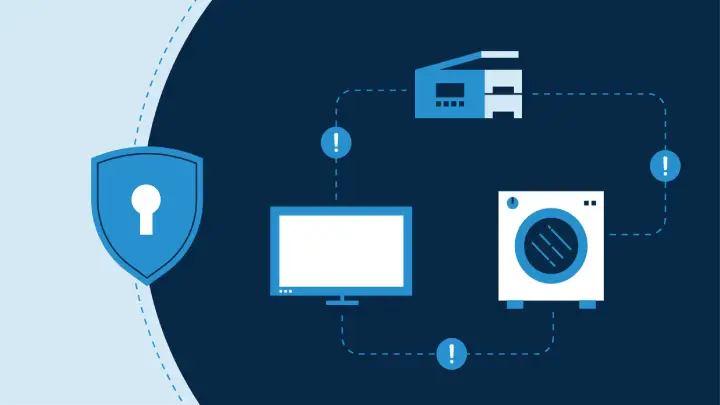Today, all sizes of businesses use loT technologies, cloud services, and SaaS applications. These components make corporate networks more complicated and difficult to protect against cyber attacks. In the last few years, cyber crimes have been skyrocketing, and cybercriminals take advantage of every vulnerability and weakness in their target’s network and security infrastructure.
Unfortunately, modern-day businesses are up against high cybersecurity risks, and they must implement security solutions that are up to date with modern-day challenges and security threats. Security threats associated with loT technologies are often overlooked by most businesses. When these technologies aren’t safeguarded adequately, they can be exploited by cybercriminals and cause data breaches.
Additionally, implementing basic security measures can’t ensure the overall security of these devices because loT systems stay vulnerable to cyber attacks. So, these systems require more advanced and sophisticated security measures to maintain complete security, and secure applications and corporate networks against loT security threats. In this regard, businesses can secure applications, loT systems, and other corporate assets by implementing Secure Access Service Edge (SASE) solutions.
SASE adaptation allows businesses to maintain security across all corporate assets, and mitigate the security risks associated with loT security threats. Before explaining what is Secure Access Service Edge (SASE) further, let’s see in detail what are the main loT security threats.
Table of Contents
Main loT Security Threats
1- Vulnerabilities
Vulnerabilities and weaknesses in loT systems are a massive security threat to organizations. By default, loT systems lack computational competence for built-in security, and this naturally causes vulnerabilities and weaknesses in loT systems. Additionally, most loT systems have limited budgets for testing and improving safe firmware, and this makes vulnerabilities common among loT systems. On top of these, vulnerabilities can stem from web applications and software for loT systems, and these vulnerabilities can lead to cyber-attacks frequently.
2- Malware
Even if businesses implement basic security measures to loT systems, it isn’t enough to maintain overall security as these systems remain vulnerable to sophisticated cyber-attacks. Cybercriminals can infect loT systems with different types of malware and execute an attack via these compromised devices. When this happens, malware can create holes in cybersecurity postures and lead to data breaches. For this reason, businesses should implement more advanced security measures to protect loT systems against malware attacks and reduce the surface areas of attacks.
3- Denial of Service (DDoS) Attacks
Compromised loT devices can be used for executing Denial of Service (DDoS) attacks. These attacks aim to shut down and disable the target machine or a network by sending heavy traffic or information that causes a shutdown. As a result, the target network or machine becomes inaccessible to all authorized users. Additionally, DDoS attacks and hijacked devices can be used to infect more devices that their target is using, or these can be entry points to access the target’s network. Once cybercriminals gain unauthorized access to their target’s network, they can steal confidential data that their target stores.
What is Secure Access Service Edge (SASE)?
Secure Access Service Edge (SASE) is a trending architecture in the cloud-computing market. This framework was introduced in 2019, and ever since it has gained momentum among businesses. SASE unifies networking and security features under an integrated cloud-native architecture. It operates in the cloud as a service and centralizes security and networking to the cloud and secures both on-premise infrastructure and cloud environments.
SASE architecture consists of five main components, and these are SD-WAN as service, Secure Web Gateway (SGW), Firewall as Service (FWaaS), Cloud Access Security Broker (CASB), and Zero Trust Network Access (ZTNA). But, SASE isn’t limited to these components only, if you like your business can add and integrate more security solutions into this framework.
Additionally, SASE architecture isn’t a single product that businesses can buy from a single vendor, but some vendors offer solutions that consist of the central concept of the architecture. Generally, SASE adaptation requires businesses to build architecture by employing technical solutions, staff participation, continual auditing, and supervision.
Core Capabilities of SASE
With its individual component Zero Trust Network Access (ZTNA), SASE adopts a security approach based on digital identity and real-time context. Digital identities can be linked to users, devices, cloud services, applications, loT systems, or any computing system. In short, all entities that request access to corporate networks must authenticate their identities via multi-factor authentication (2MFA), biometrics, or single sign-on (SSL) tools prior to their access. This way, it prevents all unauthorized entities from gaining illegitimate access to corporate networks and resources.
With Zero Trust, SASE can prohibit lateral movement of users, devices, applications, or loT systems, and limit these entities’ access inside the network perimeter. Additionally, SASE employs network segmentation which is the process of dividing a network into subnets. Applying network segmentation helps businesses to secure vulnerable loT devices from cyber attacks because this strategy prevents harmful traffic or malware from reaching these devices. In another scenario, cybercriminals can’t execute attacks via using compromised loT devices as these devices have limited access inside the corporate perimeter.
Security components like Secure Web Gateway (SGW), Firewall as Service (FWaaS), and Cloud Access Security Broker (CASB) always monitor cloud perimeter and user-generated traffic to detect malware or undesired software. Additionally, SGW and CASB enforce all required security policies in order to maintain healthy security functions.
On top of these, businesses can hide sensitive applications from others by using FWaaS. SASE’s multi-layer security framework improves security across all corporate assets and mitigates the security risks associated with cyber-attacks and loT threats. Simply put, SASE adaptation allows businesses to have enhanced cybersecurity posture and create a more secure work environment for everyone in the organization.
Last Remarks
In today’s world, using multiple cloud services, loT technologies, and SaaS applications is a common practice for all sizes of businesses. But, using loT technologies can increase security risks as these devices are vulnerable to cyber-attacks. To secure applications and all corporate assets against loT security threats, SASE is an excellent solution.

